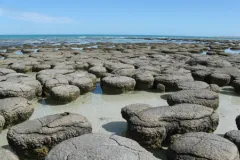Around the World Again...and Again

After the success of his first voyage, Dampier was made captain of his own ship and invited to lead the first scientific expedition to Australia (then known as New Holland). He was fascinated by all the new animals and plants he encountered. While the ship’s artist made drawings, Dampier carefully collected and preserved plant specimens to accompany his notes. Many of these can be seen and studied at the Oxford Herbarium in England today.
Unfortunately, Dampier’s rickety ship sank on the way home—resulting in a court-martial and fine, but not an end to Dampier’s career. He wrote a second book,A Voyage to New Holland. Then in 1703 he returned to the sea, circling the globe as a privateer and capturing prizes while continuing to furiously record the natural wonders he observed.
Dampier’s third and last voyage around the globe, in 1708, was also a privateering expedition. On this trip he rescued Alexander Selkirk, a pirate who had been stranded on Juan Fernandez Island off the coast of Chile for five years.
It was also on this trip that Dampier finally fulfilled his long-held dream of seizing a Spanish treasure ship. His share of the booty—jewels, silver plate, musk, cinnamon, cloves, silks, damasks and taffetas, and Chinese porcelain—provided him with a considerable fortune that enabled him to retire.
When Dampier died a few years later, at age 63, he had spent two-thirds of his life traveling the world and covered more than 200,000 miles. That’s a lot of frequent sailing miles!

